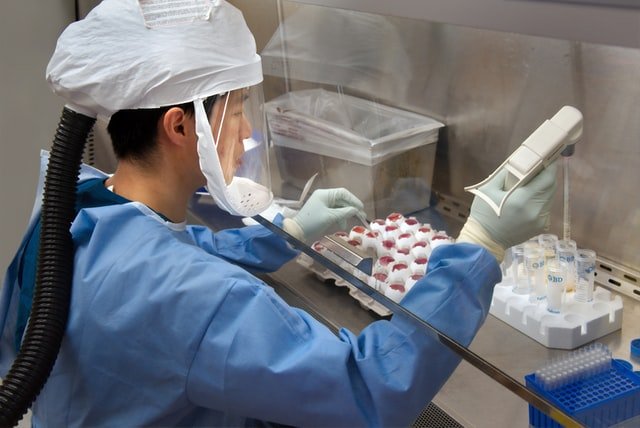LUNG CANCER
- Biotexus
- July 30, 2024
About the lungs :
When a person inhales, the lungs collect oxygen from the air and transport it to the bloodstream, where it is distributed to the rest of the body. Carbon dioxide is produced by the body’s cells when they utilize oxygen. Carbon dioxide is carried back to the lungs by the circulation, and it is expelled from the body when a person exhales.
The lungs include a wide range of cell types. The majority of cells in the lung are epithelial cells. The airways are lined by epithelial cells, which produce mucus, which lubricates and protects the lung. Nerve cells, hormone-producing cells, blood cells, and structural or supporting cells are also found in the lung.
About lung cancer :
Although cigarette smoking is the leading cause of lung cancer, the disease may affect anybody. Lung cancer can be treated regardless of its size, location, whether it has spread, or how far it has spread.
People with lung cancer may be concerned that because it is associated with smoking, they may not receive as much support or assistance from others around them. The fact is that most smokers do not acquire lung cancer, and not all lung cancer patients smoke. Lung cancer may strike anybody at any time. In reality, the majority of persons who get lung cancer today had quit smoking years ago or have never smoked.
TYPES : There are 2 main classifications of lung cancer: small cell lung cancer and non-small cell lung cancer (NSCLC). These 2 types are treated differently.
Small cell lung cancer : NSCLC begins when healthy cells in the lungs change and become uncontrollable, forming masses called tumors, lesions, or nodules. It can start anywhere in the lungs and the tumor can be malignant or benign. As malignant lung tumors grow, they can shed cancer cells. These cells can be carried away into the blood or can swim away in a fluid called lymph that surrounds the lung tissue. Lymph flows through tubes called lymphatic vessels that drain into collecting stations called lymph nodes.
Types of NSCLC :
There are different types of NSCLC. It is important to know the type of NSCLC because it can change treatment options. Doctors determine which type of NSCLC a person has based on the way the cancer looks under a microscope and the kind of cells the cancer starts in.
Adenocarcinoma. This type of NSCLC begins in the epithelial cells that line the outside of the lungs. These cells make mucus. It is the most common type of lung cancer at about 40% of all NSCLC cases.
Squamous cell carcinoma. This type of cancer starts in the squamous cells, which are flat cells that line the inside of the lungs. About 30% of all NSCLC cases are squamous cell carcinoma.
Large cell carcinoma. The cells in large cell carcinoma do not look like adenocarcinoma or squamous cell carcinoma, instead they look like large cells. This is the least common type of NSCLC and as diagnostic tools get better, more large cell carcinomas are being classified as adenocarcinoma or squamous cell carcinoma.
NSCLC-NOS (not otherwise specified) or NSCLC undifferentiated. Sometimes it is difficult for doctors to determine the type of NSCLC.
Risk Factors :
The following factors may raise a person’s risk of developing NSCLC:
Radon : This is an odourless, invisible gas that is spontaneously emitted by some soil and rocks. Radon exposure has been linked to an increased risk of some forms of cancer, particularly lung cancer. Most hardware stores provide radon testing kits, and basements may be aired to lessen radon exposure.
Air pollution : Exposure to outdoor air pollution has been linked to lung cancer in studies. Almost everyone lives in an area where air pollution is a frequent occurrence. Transportation and industrial smells, electricity generation, and smoke from intentional burning and wildfires are all common sources of pollution. People who have a history of using tobacco products are at a higher risk.
Genetics :Some people are genetically predisposed to lung cancer. People who have a father, brother, or sister who has lung cancer may be at a greater risk of having the disease themselves owing to genetic mutations.
Symptoms
People with NSCLC may experience the following symptoms or signs.
- Fatigue
- Cough
- Shortness of breath
- Chest pain, if a tumor spreads to the lining of the lung or other parts of the body near the lungs
- Loss of appetite
- Coughing up phlegm or mucus
- Coughing up blood
- Unintentional weight loss
- Hoarseness
NSCLC may spread throughout the body through a process known as metastasis. It most usually spreads to the lymph nodes, other regions of the lungs, bones, brain, liver, and adrenal gland structures surrounding the kidneys. NSCLC metastases can result in:
- More breathing difficulties
- Bone pain
- Abdominal or back pain
- Headache
- Weakness
- Seizures
- Speech difficulties
- Rarely, a lung tumor can release hormones that cause problems such as low blood sodium levels or high blood calcium levels.
Treatment :
There are 5 main ways to treat NSCLC:
- Surgery
- Radiation therapy
- Chemotherapy
- Targeted therapy
- Immunotherapy
Surgery :
The purpose of surgery is to remove the lung tumor as well as any adjacent lymph nodes in the chest. The tumor must be removed with a healthy lung tissue border or margin surrounding it. A “negative margin” indicates that no cancer was identified in the healthy tissue around the tumor when the pathologist examined the lung or a portion of lung removed by the surgeon.
The following types of surgery may be used for NSCLC:
Lobectomy: The lungs have five lobes, three in the right lung and two in the left lung. Lobectomy is the removal of the entire lobectomy. It is currently considered the most effective type of surgery, even if the lung tumor is very small. Clinical trials are underway to investigate whether less extensive surgery can produce similar results for tumors smaller than 2 centimeters.
Wedge resection : If the surgeon cannot remove the entire lobe of the lung, the surgeon can remove the tumor that surrounds the healthy edges of the lung.
Partial excision : This is another way to remove the cancer if the entire lobe cannot be removed. In a partial resection, the surgeon removes the part of the lung where the cancer has started. Partial resection usually removes more lung tissue and lymph nodes than wedge resection.
Total lung resection: If the tumor is near the center of the chest, the surgeon may need to remove the entire lung. Pneumonectomy is more risky than lobectomy, and doctors should consider the health of the heart and lungs before performing this surgery.
Radiation therapy :
The use of high-energy x-rays or other particles to eliminate cancer cells is known as radiation therapy.
Radiation treatment, like surgery, cannot be used to treat extensive cancer. Radiation therapy can only kill cancer cells that are directly in the path of the radiation beam. It also causes harm to the healthy cells along its path. As a result, it is not suitable for treating broad regions of the body. Intensity modulated radiation treatment (IMRT) or stereotactic body radiation therapy (SBRT) may be employed in some cases. These methods of radiation treatment employ CT or PET scans to precisely direct the radiation beam in order to reduce the danger of injuring healthy portions of the body.
Therapies using medication :
The types of medications used for NSCLC include:
- Chemotherapy
- Targeted therapy
- Immunotherapy
Chemotherapy :
Chemotherapy is the use of medications to eradicate cancer cells, often by preventing cancer cells from growing, dividing, and proliferating. It has been demonstrated to increase both the duration and quality of life for persons with all stages of lung cancer.
Chemotherapy has the potential to harm healthy cells in the body, such as blood cells, skin cells, and nerve cells.
Targeted therapy :
Targeted therapy is a type of cancer treatment that targets specific genes, proteins, or the tissue environment that contributes to cancer development and survival. This sort of therapy inhibits cancer cell development and spread while protecting healthy cells.
Not all cancers have the same objectives. Your doctor may order tests to determine the genes, proteins, and other variables in the tumor in order to discover the most effective treatment.
NSCLC targeted treatment includes:
Drugs targeting KRAS G12C mutations. One of the most prevalent genetic variants detected in persons with NSCLC is KRAS G12C. KRAS mutations are seen in 20 to 25% of lung cancer patients.
Drugs targeting RET fusion. RET fusion is seen in up to 2% of all NSCLC cases.
Anti-angiogenesis therapy. Anti-angiogenesis treatment halts angiogenesis, or the formation of new blood vessels. Because tumors require the nutrients given by blood vessels to develop and spread, anti-angiogenesis medicines aim to “starve” the tumor.
Immunotherapy :
Immunotherapy, also known as biologic treatment, is intended to increase the body’s natural defenses against cancer. It employs components created by the body or in a laboratory to enhance, target, or restore immune system activity.
Immunotherapy can employ the body’s immune system in a variety of ways to treat cancer.
Drugs that block the CTLA-4 pathway. The CTLA-4 immunological pathway is another potential target.
Drugs that block the PD-1 pathway. The PD-1 pathway might play a significant role in the immune system’s capacity to regulate cancer progression. For some individuals, blocking this pathway with PD-1 and PD-L1 antibodies has prevented or delayed the development of NSCLC.
Prevention :
The most essential approach to avoid lung cancer is to avoid smoking. People who never smoke are at the lowest risk of developing lung cancer. Even those who have smoked for a long period can minimize their risk of lung cancer by quitting.
Attempts to prevent lung cancer via the use of vitamins or other therapies have failed. For example, beta-carotene, a vitamin A-related medication, has been studied for the prevention of lung cancer. It had no effect on cancer risk. Beta-carotene actually raised the risk of lung cancer in persons who continued to smoke.



















